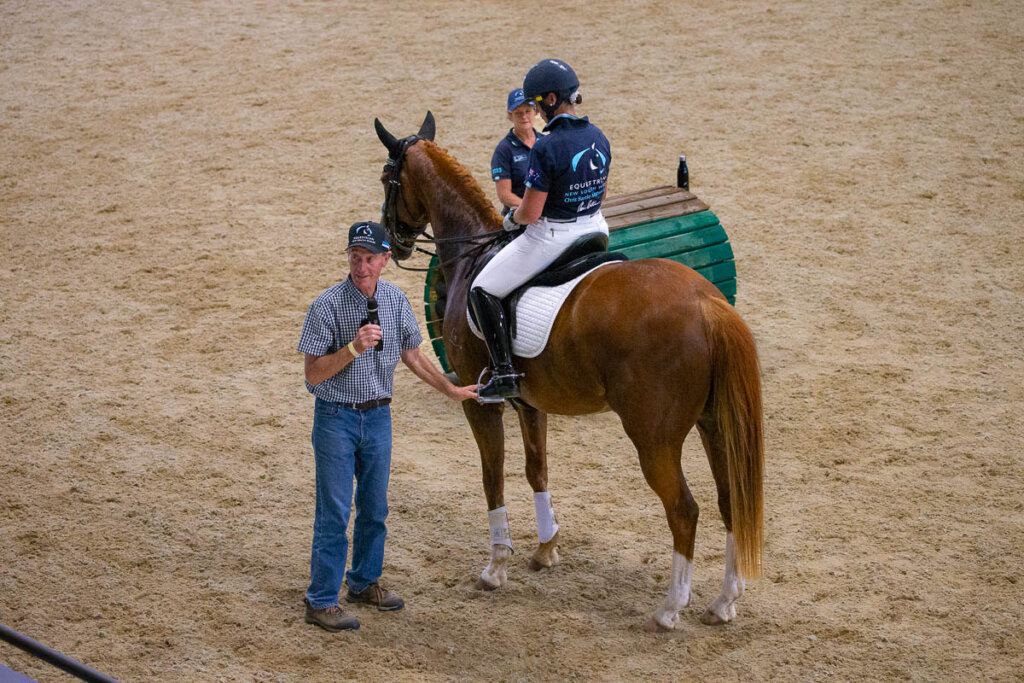
”Christopher has a very simple system to communicate with the horse. First, you make a POSITION STATEMENT, putting the body into position to tell the horse what it’s going to do. It’s the preparation. Next we use BODY LANGUAGE to tell the horse when it’s going to do it. It’s the action. This is then supported by the SEAT for length of stride and the LEG which is for energy and FINALLY THE HAND.”
As Albert Einstein once said, “The definition of a genius is taking the complex and making it simple”. Christopher Bartle is definitely a genius. During his recent visit to Australia he proved, if it ever needed to be proved, his prolific understanding of the equestrian sport and he has exquisite communication skills.
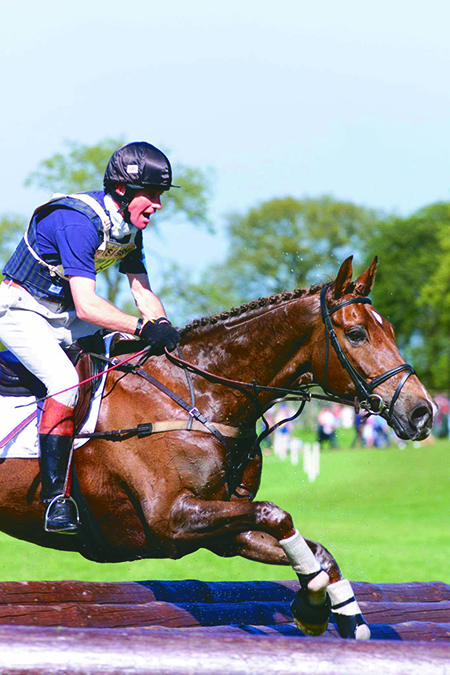
Christopher and Word Perfect, winning at Badminton in 1998
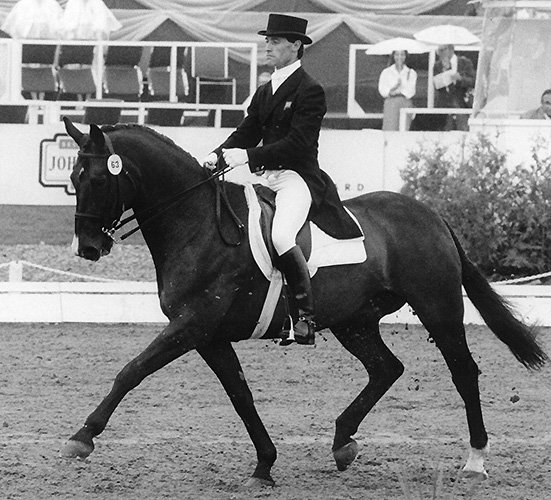
Christopher and Wily Trout at the LA Olympics
As a rider, not only did Christopher win Team Gold at the European Championships in Burghley in 1997 and Badminton in 1998 on Word Perfect II, but also had great success in the dressage arena coming 6th in the LA Olympics in 1984 and 2nd in the Dressage World Cup Final in ’s-Hertogenbosch in 1986 aboard Wily Trout.
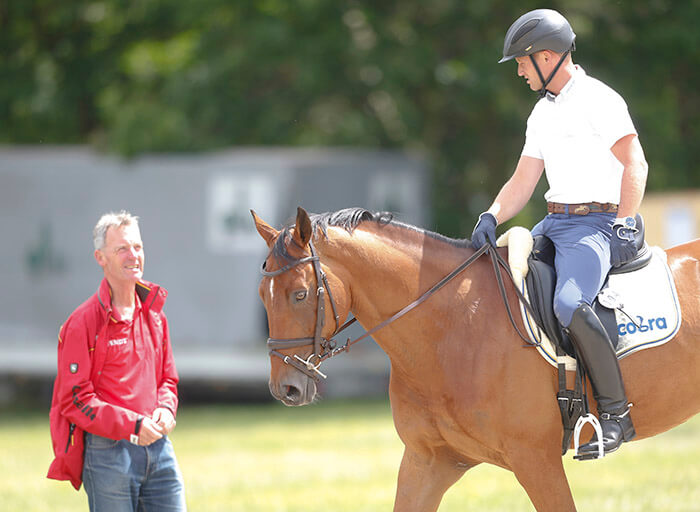
Christopher and one of his star combinations for Germany, Michael Jung and Sam
As a trainer, between 2001 and 2016, Chris helped transform the German eventing team into a medal winning machine. Since 2016, he has been doing the same as coach of Team GB.
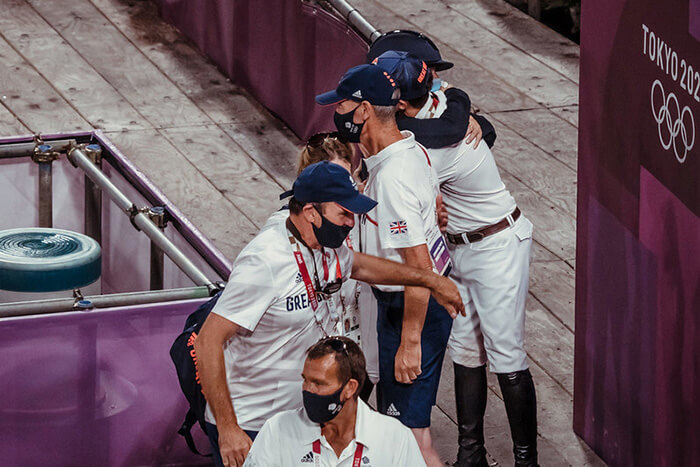
A team hug for the coach of the victorious UK team in Tokyo in 2020
(FEI photo: Christophe Taniere)
To split Chris’s training between cross country and dressage is a little tricky as his philosophy really extends over all disciplines. His whole approach is to encourage the horse and motivate him to perform rather than pressure him to perform. “Basically we communicate through the language of touch.”
On this visit to Australia, not only did Christopher teach clinics but also conducted a Masterclass and Coaches Masterclass at Sydney Three Day Event thanks to Equestrian NSW. It’s these two latter events that are reported on here.
We’ll start with dressage, and what a surprise it was to those horses used to nothing but white rails to find themselves in an indoor full of cross country jumps! A training experience in itself.
Christopher has a very simple system to communicate with the horse. First, you make a POSITION STATEMENT, putting the body into position to tell the horse what it’s going to do. It’s the preparation. Next we use BODY LANGUAGE to tell the horse when it’s going to do it. It’s the action. This is then supported by the SEAT for length of stride and the LEG which is for energy and FINALLY THE HAND.
The outside hand is the DISCIPLINE REIN. It talks to the horse, asks him to wait, is used in a slight outward direction. The inside rein is the FRIENDLY REIN and is used by lifting the bit to the corner of the mouth to take the pressure off the tongue and the jaw. It affects the poll and is more comfortable there for the horse. It’s never used with backward pressure.
Chris also reminded the riders to sit to the inside edge of the saddle, especially on circles and in lateral work.
“It’s not a fault, it’s just that the centrifugal force will pull you to the outside of the saddle so you need to just gently correct that every few strides.”
In fact, any aids to the horse are to be be given just once every few strides. Touch, two, three, four, touch, two, three, four was a mantra for all riders. This had to be done in rhythm though so as not to confuse the horse. No one was to hassle their horse or double tap with the leg or spur.
Another much heard correction was to “let fresh air under your thigh”. Clamping legs were out of the equation. No gripping legs; no holding hands and nice, loose hips.
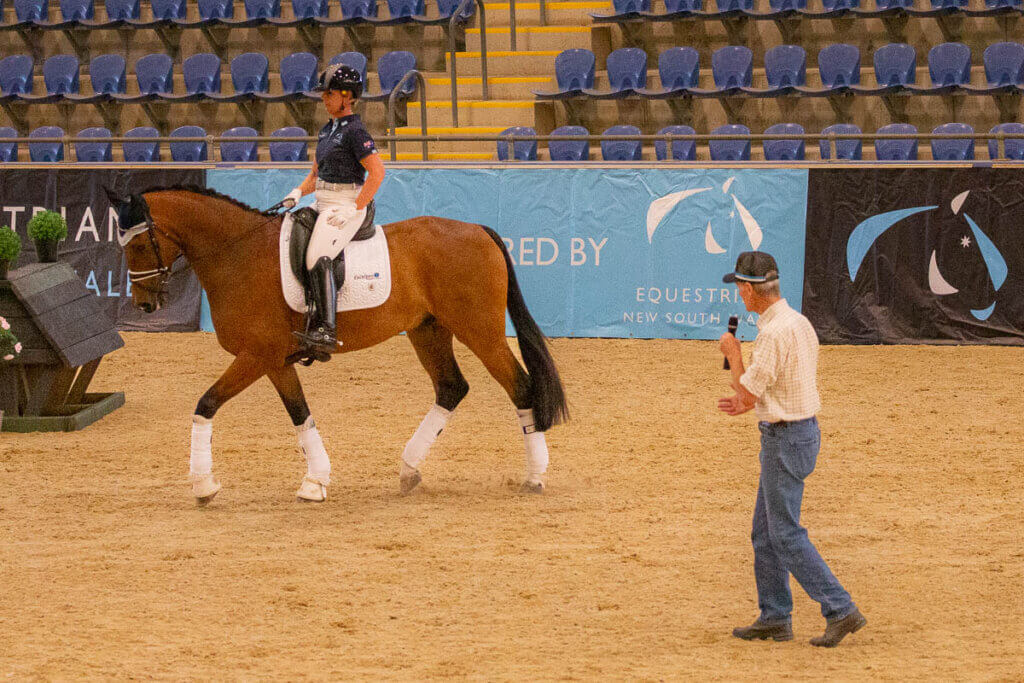 Rochelle King-Andrews and H.V. Florian demonstrate…
Rochelle King-Andrews and H.V. Florian demonstrate…
Most riders were asked to ride with the reins in one hand at some point. The horses became quieter in the mouth, softer in the outline and not so short in the neck. It was to point out that by taking away the hands and communicating to the horse more from your body, you achieve a better frame, connection and outline.
“I see too much pressure at the front end, fussy hands which leads to a tight neck.”Reins are held in the outside hand because that’s the disciplining rein. The work at all levels was first and foremost about freedom of movement, expression, that “up” attitude but without too much holding and squeezing.
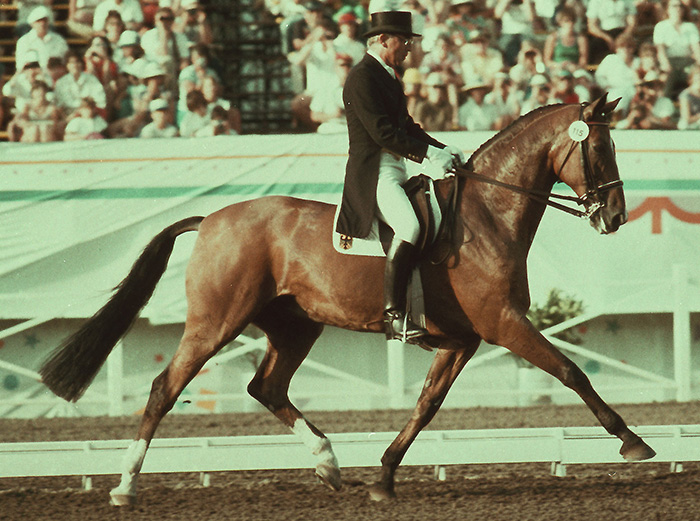 Dr Reiner Klimke and Ahlerich – an inspiration..
Dr Reiner Klimke and Ahlerich – an inspiration..
Christopher mentioned being helped by the great Reiner Klimke at times during his career and being utterly impressed when Klimke and Ahlerich did their lap of honour at the LA Olympics with one-handed piaffe, passage and flying changes.
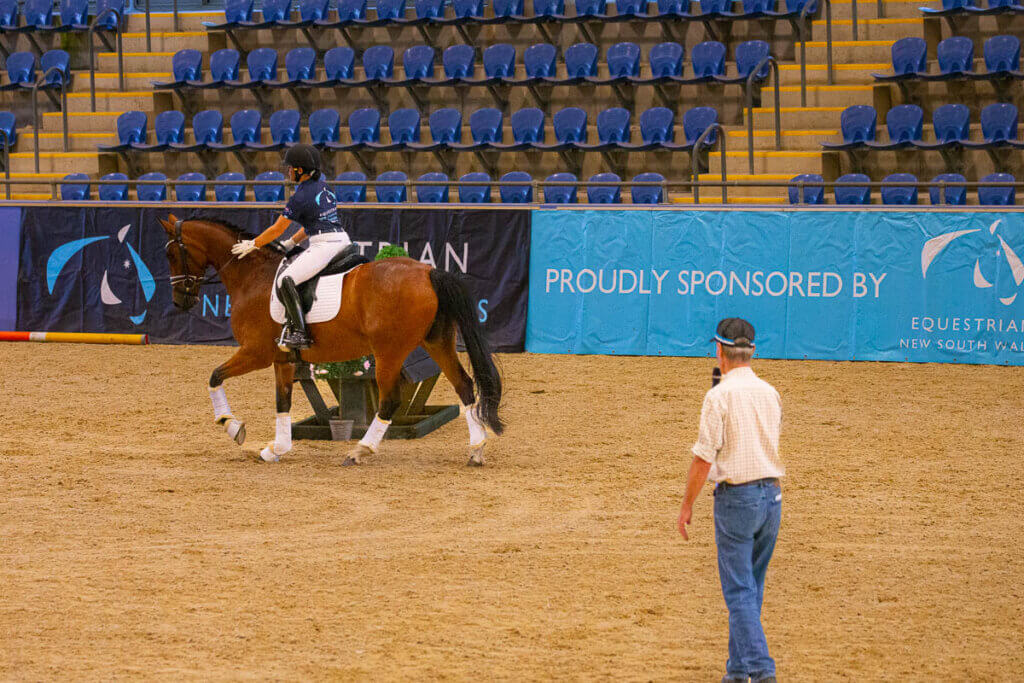 Nineteen-year -old Brooke Gatt on her young horse Celestial was encouraged to have the rein a fraction longer.
Nineteen-year -old Brooke Gatt on her young horse Celestial was encouraged to have the rein a fraction longer.
“Active…your body position says let’s go! You step down into your inside stirrup in your rising trot. Work from your hip, not your knee. When you change direction, step into your new inside stirrup, open your new inside hip and knee, raise the bit with your inside hand, control with the outside rein and say let’s go with your body.”
Christopher was really looking for positive paces and communicating to the horse with weight aids.
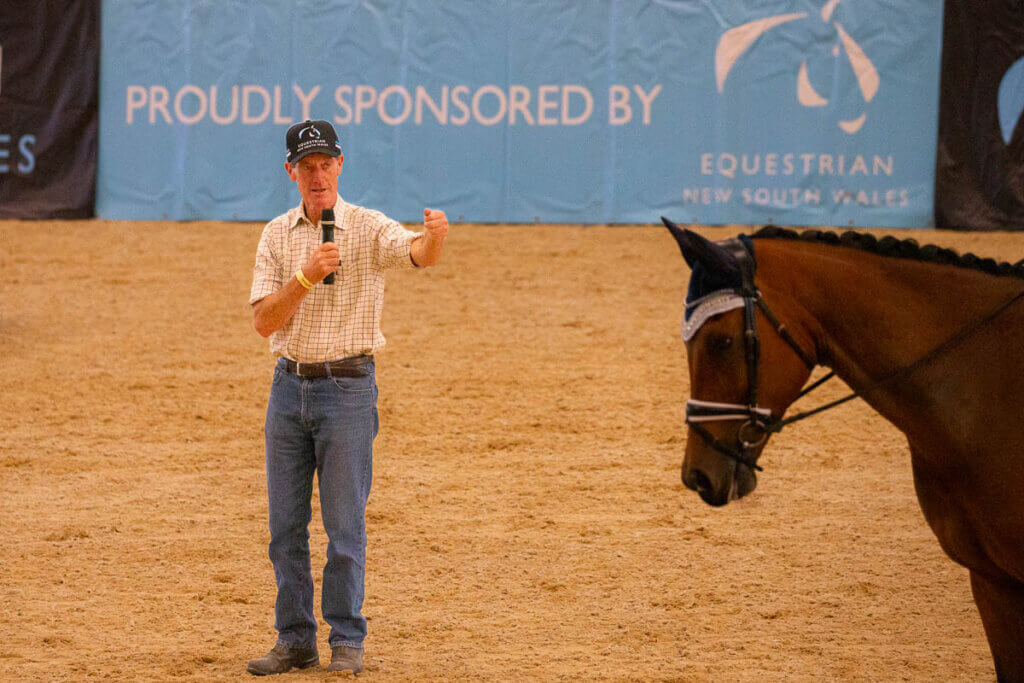
Rochelle King-Andrews and HV Florian were the Medium combination. Florian was impressed with this interesting environment and Chris guided:
“Relax your hip to allow your horse to ‘breathe’ a little bit, especially when they’re in a new environment. Let the nose forward a little bit more, fractionally longer rein. Lift the inside rein rather than pull back. Lower your hand fractionally. Let him step forward.”
Rochelle was to use shoulder in to get Florian into what Chris calls The Zone then, with this established, take it forward into bigger strides as she straightened. This ws followed by half pass and Rochelle was encouraged to touch the horse with the inside leg every four strides to create more expression. “The preparation phase creates relaxation and then you can say let’s go. The shoulder in activates the hind leg first. Relax your hips so you get bigger strides. The horse must feel free to move.” Rochelle executed the movement beautifully.
“Half pass, shoulder in then circle left. You want your inside leg under your inside hip. Step to the inside and half halt with the outside rein. This is what I mean by body language. Your body is now riding a bigger step.”
In the preparation work for the pirouettes, it was all about just little reminders to the horse and not taking the outside leg further back. It should talk to the front end and this way you can ride the horse forward.
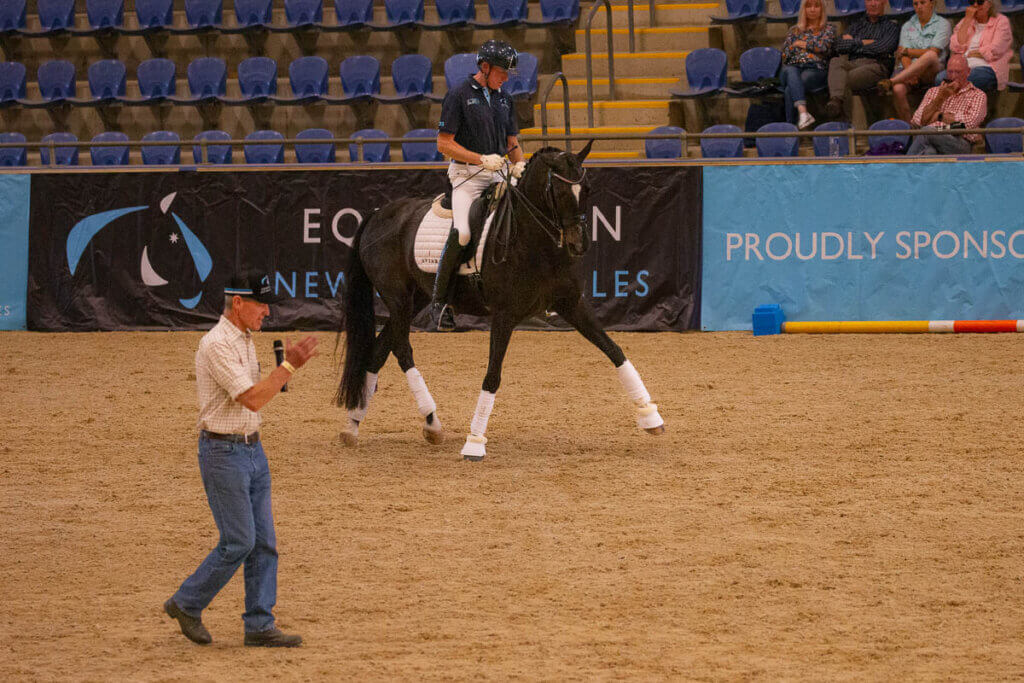
Mark Kiddle and Pennyhill Park Sophia
Mark Kiddle and Pennyhill Park Sophia were the Grand Prix representatives. After an initial check to ensure the combination were forward, uphill and easy together with rhythm and relaxation, shoulder in was asked for to get the talented mare’s hind leg more under the body.
The mare’s nose was encouraged forward by a slightly longer rein and Mark relaxing his arm, but not throwing away the contact. More collection came about with a less driving, looser hip and thigh. Trot with an almost walk transition then back into trot also encouraged a more engaged hind leg as did keeping the shoulder in through the trot to walk transitions. The trot to almost walk could also be the start of the passage training.
Mark and Sophia produced a fabulous big and ground covering canter. To bring it back, Chris advised, “Collect by your body language saying now I’m cantering on the spot. The neck doesn’t change, your hips stay loose. Bigger seat movement to ride out. It’s your body communicating to the horse, not so much the leg. The leg is just one touch for an extra boost.” To make the tempi changes more ground covering, Chris explained, “Our horses feel what we’re doing so position your hips and then your body starts communicating it. It’s your hips swinging with your horse not just a mechanical movement of your leg. Then you will get more expressive changes.”
The pirouettes again were initiated from the hips with the inside leg there for support. The feeling should be one of skipping with your horse.
The session ended with a little look at piaffe using the walk pirouette as preparation. “Always shoulder fore as the preparation. Relax your hip and keep your leg closer to girth. Then you can take your legs a fraction further forward for piaffe. That will help lift the shoulder.”
Focus on a diagonal pair to get from piaffe to passage. That stops you just focusing on the front end or back end.
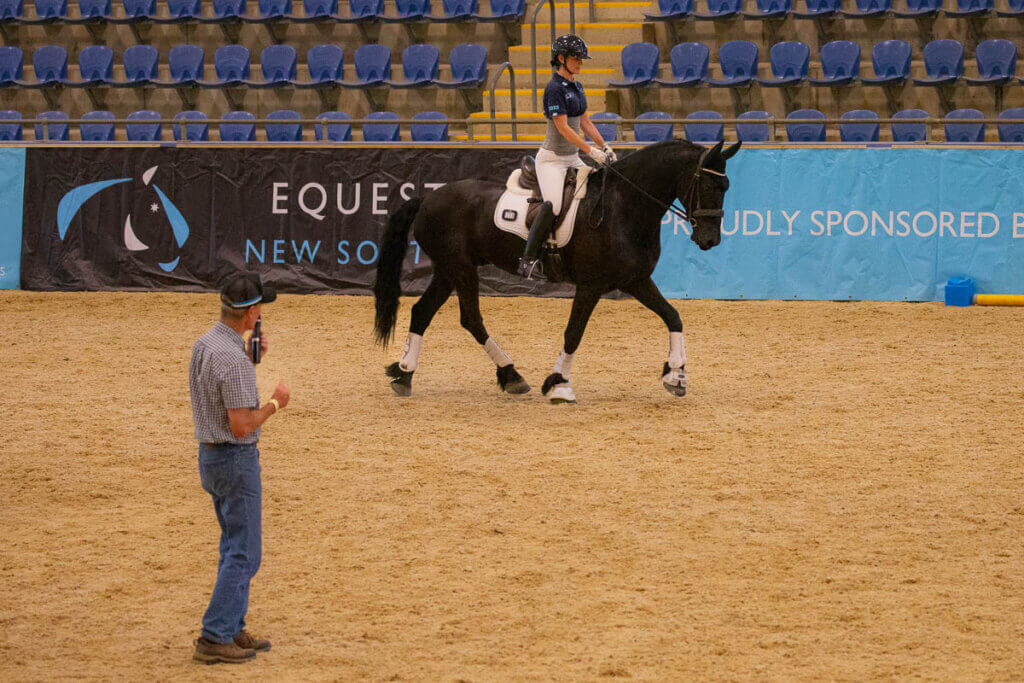
Heidi Ford and Reike
In the Coach’s Clinic the following day, the dressage section began with Heidi Ford and her Friesian Reike. Heidi competes both able body and para dressage. She was encouraged to activate her gelding using shoulder in and the body language of “Let’s go!”. It was important to not over bend the neck when asking for poll flexion and It was to be the body position that brought the horse back for collection or downward transitions rather than pressure in the mouth. Contact does not equate to pressure. “Feel like you’re dancing with your horse!” encouraged Christopher.
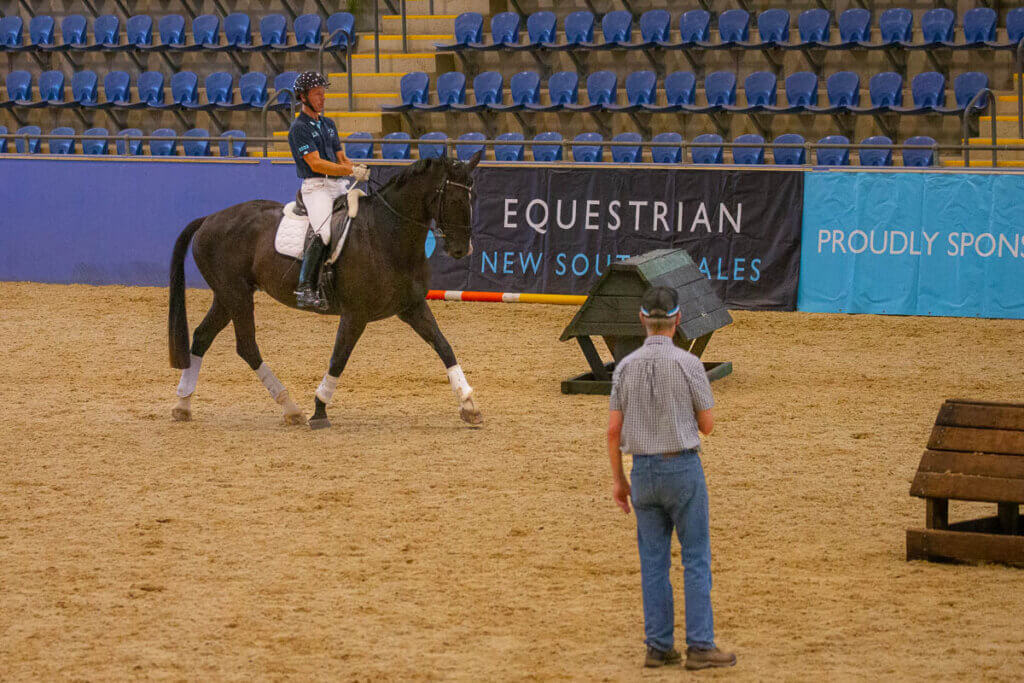 Justin Worthy and Mario
Justin Worthy and Mario
Justin Worthy on Sally-Ann Barbera’s Mario showed us some Prix St Georges work. Basics first and Chris wanted to check that the horse was forward thinking, supple and with correct poll flexion. Is the rider relaxed? Is he touching the horse in a rhythm and not wrestling or hassling the horse? Lots of transitions between and within the paces he calls “Phase One” of the daily work. “During the LA Olympics, my trainer used to make me do a lot of these transitions with Wily Trout. And also medium trot to medium canter with a constant outline, constant contact.”
Again Chris’s great analogies came to the fore, “Imagine a glass of champagne is sitting at the top of the bridle but the poll flexion shouldn’t spill the glass of champagne. If he rolls over, shoulder fore. One touch of the inside leg, then outside leg.”
In the trot/walk transitions. It was important to remind the gelding to stay up a bit, maybe from a touch of the rider’s back, maybe from a slight bracing of the back. “Dance into the canter, don’t just mechanically use the leg.”
Phase Two of the work then began with lateral movements: shoulder in to travers to half pass. There was the little reminder, “An athlete can’t compete in tight clothing. Don’t make your body tight in and around the horse.” The horse’s shoulder was encouraged to lift by either a touch on the shoulder with the whip or a touch of the inside leg forward. The inside leg is also used to activate the inside hindleg which will then keep the poll up and the nose forward.
Each exercise should be followed by a “recovery period” of a short stretch in that pace, a little bit like interval training.
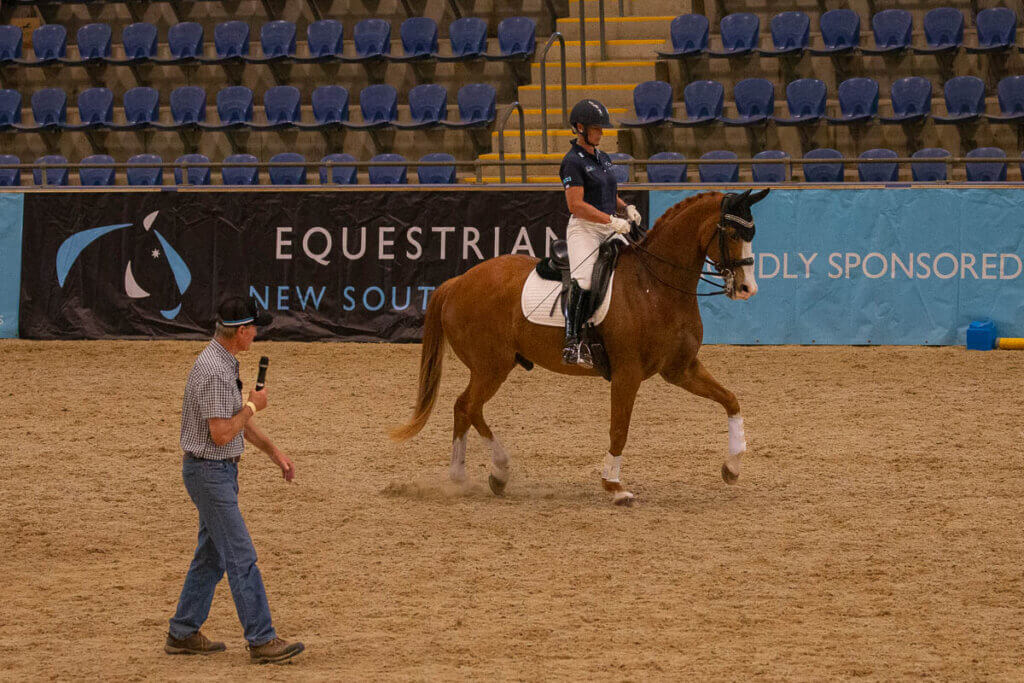 Holly Lewis and Heatherton Park Romeo
Holly Lewis and Heatherton Park Romeo
Holly Lewis and Heatherton Park Romeo were showing some Grand Prix work. The chestnut was a little taken aback with his new surrounds and got shy and a little chewy in the mouth despite Holly’s soft hands. Chris suggested perhaps sometimes training him in a simple snaffle or, when in the full bridle, maybe holding the inside snaffle rein from underneath. “Avoid pressure on both sides of the mouth at the same time. Left flexion, then right flexion to get him stretching forward more. You want to get it by relaxation, not pressure.” Chris calls this “shimmying”.
It was also worth considering that constant contact of the horse with the seat, leg and hand didn’t mean constant pressure, and that the leg should be used in a forward direction. Not that Holly did it, but Chris also wanted us to consider that the leg shouldn’t be pinned in at the knee with the spur working backwards.
The leg should hang at the girth. Only when the leg needed to address the quarters was it to come backwards. The whip too should be carefully applied and used with precision avoiding the belly and flank.
If forced to encapsulate Chris’s philosophy into one quote, it might have to be, “Allow your horse to perform as your dancing partner”. Allow being the operative word.
A huge thank you to Vireena Peacock and Dressage NSW for the very special Masterclass and Coach’s Clinic. Also to Karen Miller at Ballodair Equestrian Centre who allowed access to Christopher’s clinic. It’s not every day you get the opportunity to learn from the world’s best. And the biggest thanks of all to the horses and riders who put themselves in the spotlight to be critiqued to help us all learn. That’s no mean feat.

Great recap, Rebecca. It was such a privilege hosting Christopher Bartle, and watching him work miracles.
I had lessons from Chris in SA in the early 90s – I still hear his words, especially ‘set up the canter pirouette then allow it to happen’ – a great rider & trainer.